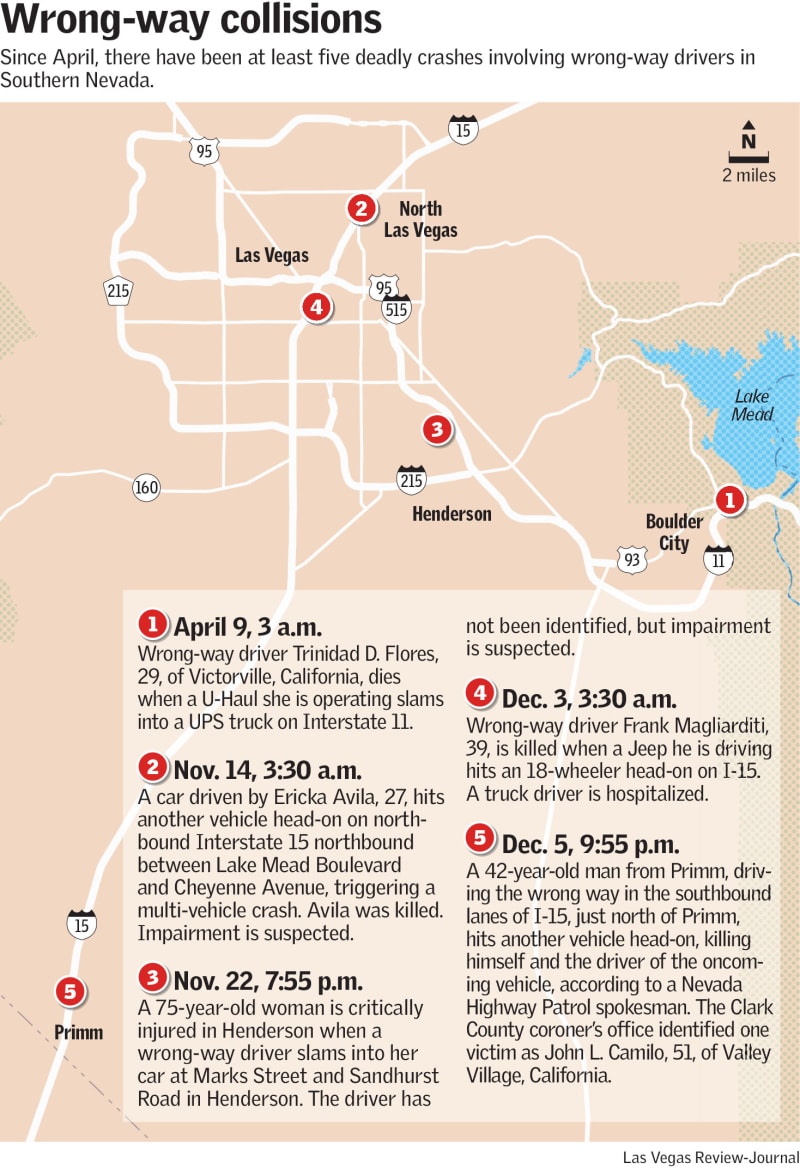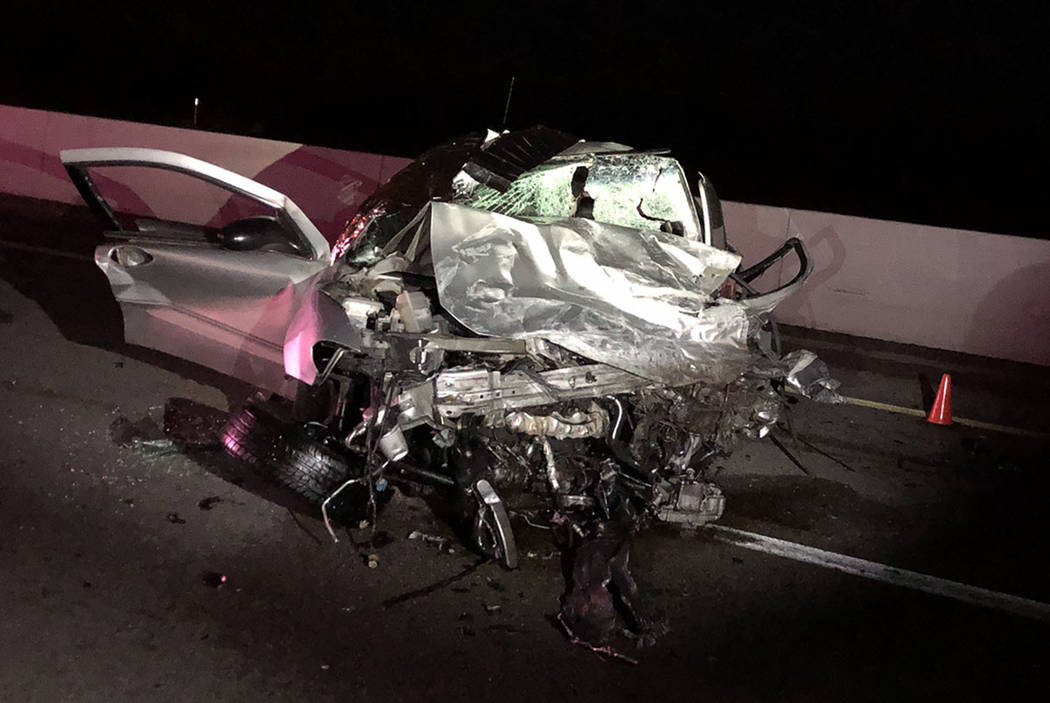Other states already using technology to combat wrong-way drivers
Technology in use in Rhode Island, Arizona and Texas may provide a road map to help Nevada prevent wrong-way crashes, officials say.
Since Nov. 14, four people have died in wrong-way crashes in Southern Nevada on Interstate 15 alone. The most recent occurred Thursday night, when two motorists were killed in a wrong-way crash on I-15 near Primm.
That crash happened just two days after a motorist was killed driving the wrong way on I-15 at Charleston Boulevard. Three weeks earlier, on Nov. 14, yet another wrong-way driver was killed on I-15 in a crash near Cheyenne Avenue.
“This is not a new issue,” said Melisa Finley, a research engineer at the Texas A&M Transportation Institute who has studied wrong-way crashes extensively. “It has been around since the ’50s, when the interstate system started … but it seems to be becoming more prominent again.”
There are trends in wrong-way crashes, Finley said. They typically involve impaired drivers. They usually happen at night and are often lethal. For reasons no one fully understands, they can happen in clusters, such as the recent spate in Southern Nevada.

‘Rare and random’
“I will just say that these crashes, in general, are rare and random events,” Finley said. “And when we do see a cluster of crashes happen, then you may not see them happen again for several months or a year or so. And then all of a sudden, for some reason, you have a rash of them again, and there is not always a good explanation for that.”
These clusters of crashes have caused several states to try to limit the carnage. In Nevada, authorities are launching a pilot program to alert people of a wrong-way driver. The Nevada program has similarities to one already in place in Rhode Island, where 10 fatal wrong-way crashes killed 13 people over a five-year period.
“We were seeing a spike of wrong-way crashes here in Rhode Island,” said Charles St. Martin, spokesman for the Rhode Island Department of Transportation. “We definitely saw this alarming trend that got us working closely with our state police, looking at the data.”
Rhode Island studied the intersections where it appeared wrong-way drivers had accessed the highway.
“They tended to be more of the older-style intersections with on- and off-ramps T-ing up to the same road, versus a cloverleaf,” St. Martin said.
Rhode Island installed a “a radar-based” detection system called the Rhode Island Wrong-Way Mitigation Project on 24 ramps. As a wrong-way driver enters the ramp, bright LED signs warn that the driver is headed the wrong way.
“If the vehicle keeps going through a couple of different zones … it would set off an alarm in our transportation management system,” St. Martin said.
The system notifies the Rhode Island State Police of a wrong-way driver, takes a picture of the vehicle and, if necessary, displays a message on overhead signs to warn others in the immediate area that a wrong-way driver is approaching.
Drivers turn around
The system has been remarkably effective.
“An apparent wrong-way driver has gone through the system approximately 150 times,” St. Martin said. “Of all those instances, we have only had one crash and no fatalities. … In most of the cases, we are seeing the drivers turning around. It takes photos and we see vehicles stop, make a three-point turn and turn around and go back.”
The Nevada Department of Transportation’s pilot program is similar. The system is being installed at the U.S. Highway 95 exit ramp at Durango Drive, in the northwest Las Vegas Valley. The system uses a camera and an electronic sensor, which alerts wrong-way drivers on the ramp by triggering strobe-like beacons on wrong-way signs.
The system is expected to be up and running in early 2020. Each system costs roughly $100,000 and will also alert first responders and traffic management personnel to allow for electric signage notification of oncoming drivers.
“I’m certainly optimistic,” said Mario Gomez, an engineer for NDOT. “It is another tool in the toolbox to promote driver safety.”
The Texas Department of Transportation, facing the same problem in the San Antonio area, formed the San Antonio Wrong Way Driver Task Force. The result was a notification system for law enforcement and motorists alike.
A photo on the Texas DOT website shows the system in action, with an electronic sign above an interstate reading “Wrong Way Driver Reported — Use Extreme Caution.”
Arizona is testing a thermal camera-based wrong-way vehicle detection and warning system along a 15-mile stretch of Interstate 17 in Phoenix, Doug Nintzel, spokesman for the state Department of Transportation, said in an email to the Review-Journal.
“The results to date have been promising,” Nintzel said. “So far the system has detected more than 90 wrong-way vehicles (since January 2018).”
“These measures can reduce risk, but can’t prevent wrong-way driving,” the ADOT website states. “Two out of three wrong-way crashes are caused by impaired drivers and often these drivers have blood-alcohol levels more than twice the legal limit. This public safety issue will not be solved by only engineering and enforcement. We all need to work to keep impaired drivers from getting behind the wheel.”
Contact Glenn Puit at gpuit@reviewjournal.com or 702-383-0390. Follow @GlennatRJ on Twitter.


















